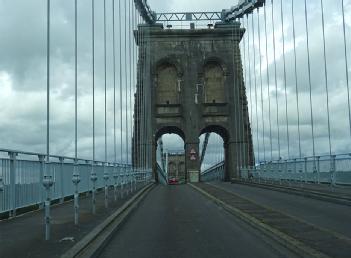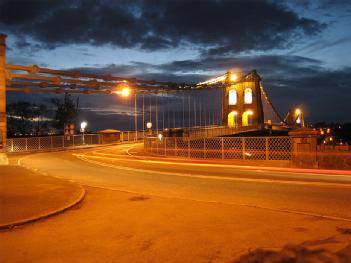
Menai Suspension Bridge |
LL57 2HZ Bangor, Great Britain (UK) (Wales) |
|
| Address |
|
| Floor area | unfortunately not known yet |
Bridges and Tunnels
- Historic Engineering Landmarks
|
Opening times
|
|
|
Status from 01/2017
|
Free entry. |
| Contact | Unknown contact data for this museum - please help via contact form. |
| Homepage | |
| Location / Directions |
The Menai Suspension Bridge (Welsh: Pont Grog y Borth) is a suspension bridge to carry road traffic between the island of Anglesey and the mainland of Wales. Bangor is a city in Gwynedd unitary authority, north west Wales, and one of the smallest cities in the United Kingdom. It is the oldest city in Wales Bangor lies at the western end of the North Wales Path, a 60-mile (100 km) long-distance coastal walking route to Prestatyn. It is also on routes 5, 8 and 85 of the National Cycle Network. Bangor railway station, which serves the city, is located on the North Wales Coast Line from Crewe and Chester to Holyhead. The A55 runs immediately to the south of Bangor, providing road transport to Holyhead in the west and Chester to the east. The nearest airport with international flights is Liverpool John Lennon Airport, 83 miles away by road. |
| Description | Construction Before the bridge was completed in 1826, the island had no fixed connection to the mainland and the primary means of access to and from Anglesey was by ferry across the fast flowing and dangerous waters of the Menai Strait. Because of the high banks and fast flowing waters of the Strait, it would have been difficult to build piers on the shifting sands of the sea-bed and, even if it could be done, they would have obstructed the navigation. Also, the bridge would have to be high enough to allow the passage of the tall ships of the day. In view of this, Telford proposed that a suspension bridge should be built and his recommendation was accepted by Parliament. Construction of the bridge, to Telford's design, began in 1819 with the towers on either side of the strait. These were constructed from Penmon limestone and were hollow with internal cross-walls. Then came the sixteen huge chain cables, each made of 935 iron bars, that support the 176-metre (577 ft) span. To avoid rusting between manufacture and use, the iron was soaked in linseed oil and later painted. The chains each measured 522.3 metres (1,714 ft) and weighed 123 t. Their suspending power was calculated at 2,048 t. The bridge was opened to much fanfare on 30 January 1826. Later historyThe roadway was only 24 feet (7.3 m) wide and, without stiffening trusses, soon proved highly unstable in the wind. The deck of the Menai Bridge was strengthened in 1840 by W. A. Provis and, in 1893, the entire wooden surface was replaced with a steel deck designed by Sir Benjamin Baker. Over the years, the 4 1⁄2-ton weight limit proved problematic for the increasing freight industry and in 1938 the original wrought iron[6] chains were replaced with steel ones without the need to close the bridge. In 1999 the bridge was closed for around a month to resurface the road and strengthen the structure, requiring all traffic to cross via the nearby Britannia Bridge. On 28 February 2005 the bridge was promoted to UNESCO as a candidate World Heritage Site. On the same day one carriageway of the bridge was closed for six months restricting traffic to a single carriageway so that traffic travelled to the mainland in the morning and to Anglesey in the afternoon. The bridge was re-opened to traffic in both directions on 11 December 2005 after its first major re-painting in 65 years. Characteristics Design: Suspension bridge |
[dsp_museum_detail.cfm]
| Data Compliance | More Information |







